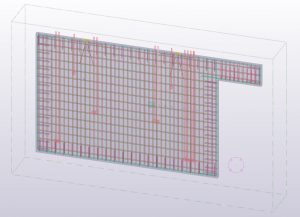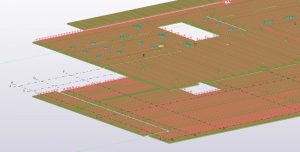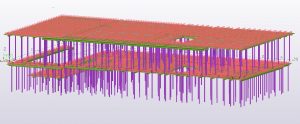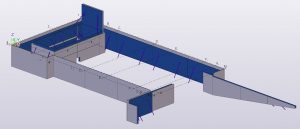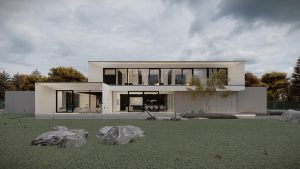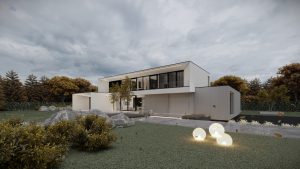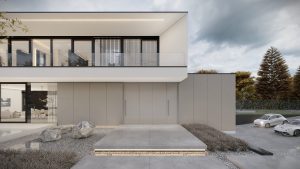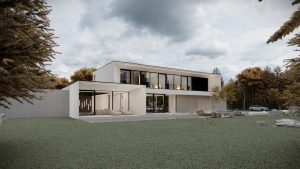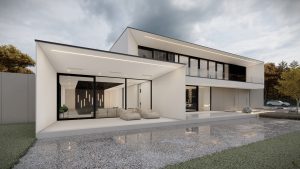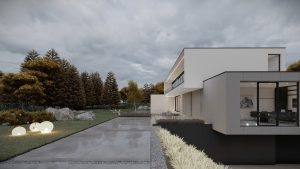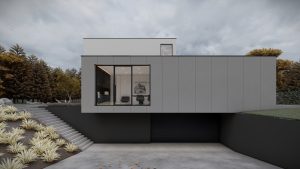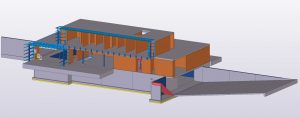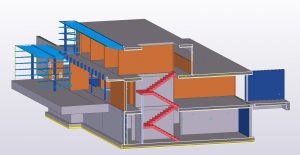DISPLAY HOUSE
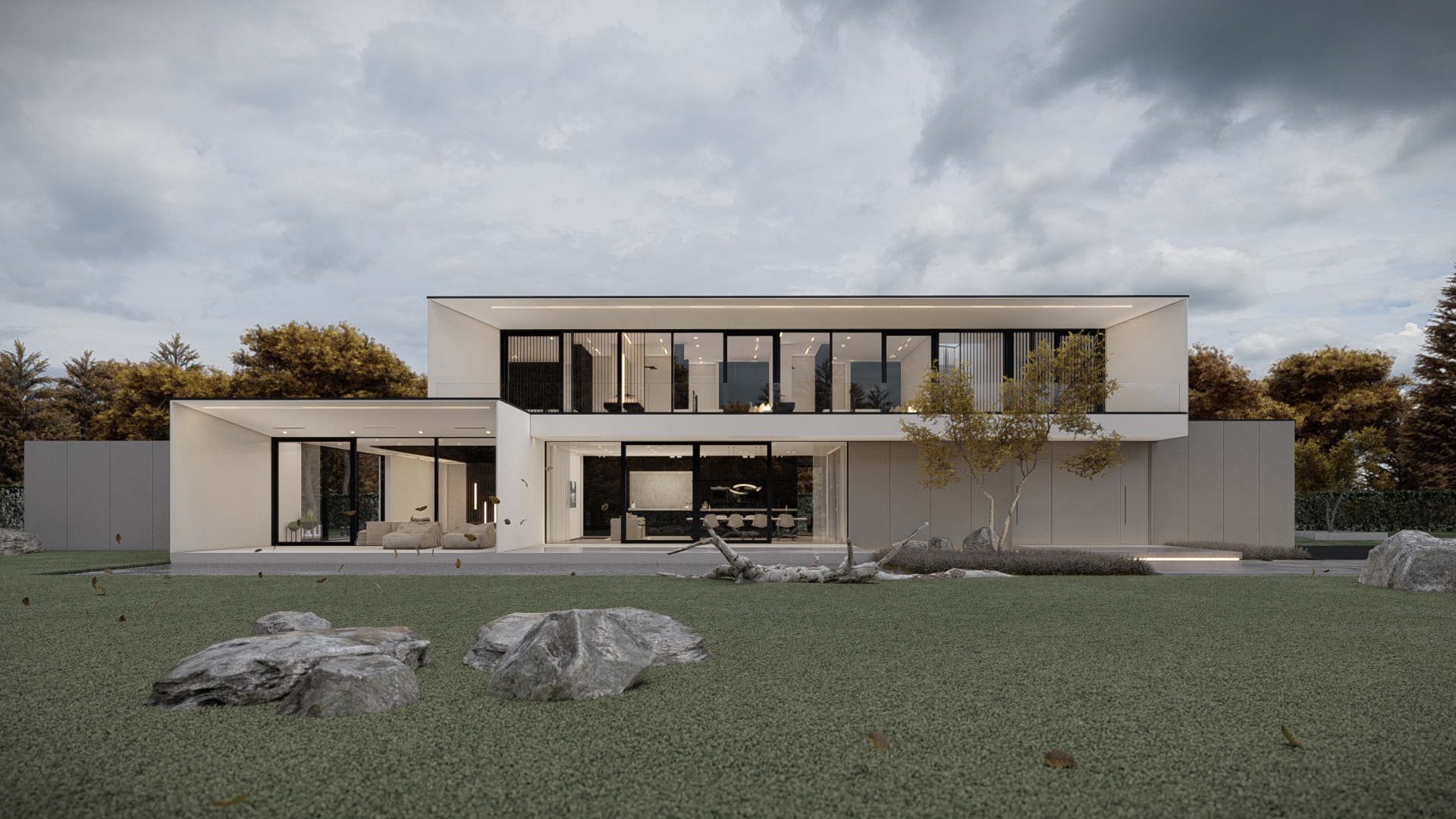
| Categorie | Kleinschalige projecten |
|---|---|
| Jaar | 2022 |
| Land | Benelux |
| Organisatie | Buro de Haan |
| Projectpartners | Bouwbedrijf: Groenveste; Architect: STATE of Architecture |
| Auteur | Peter Plaggenmarsch |
| Plaats van constructie | Huizen |
| Tags |
Dit project betreft de constructie van een vrijstaande woning, bestaande uit drie bouwlagen. De onderste bouwlaag bestaat onder andere uit een kelder met zwembad en hellingbaan. Vanaf de start van de technisch ontwerpfase is de constructie volledig gemodelleerd in Tekla Structures. Daarbij zijn de verschillende rollen van Tekla gebruikt.
Technisch ontwerp
In eerste instantie is de rol Engineer gebruikt voor het opzetten van het technisch ontwerp. De keldervloer en hellingbaan is in het werk gestort. De kelderwanden bestaan uit een holle wand systeem. De binnenwanden van de kelder zijn gemaakt van prefab beton en het kelderdek, bestaande uit een breedplaatvloer, maakt de constructie van de kelder compleet.
De begane grond bestaat uit geprefabriceerde keramische wanden, enkele stalen kolommen en de vloer erboven uit een breedplaatvloer gecombineerd met een enkele stalen ligger. Dit geldt ook voor de bovenste bouwlaag.
Verder zijn de trappen in en buiten de woning van geprefabriceerd beton en aan de voorzijde van de woning zijn luifels aanwezig die worden gedragen door gezette stalen profielen.
Het model van het technisch ontwerp is geëxporteerd naar IFC en in andere software geclasht met modellen van andere disciplines zoals het bouwkundig en installatiemodel.
In het werk gestort beton
In de uitvoeringsfase zijn de in het werk gestorte betononderdelen gemodelleerd, inclusief wapening. Vervolgens zijn tekeningen met details gegenereerd en opgemaakt voor de uitvoering.
Holle wanden en prefab betonwanden
Met de rol Precast Concrete Detailer zijn de holle wanden uitgewerkt voor én volgens de voorschriften van de leverancier inclusief in te storten voorzieningen. De holle wanden zijn afgestemd op de installaties door het installatiemodel (IFC) als referentiemodel in te voegen. Daaropvolgend zijn de productie- en montagetekeningen gemaakt. Op dezelfde wijze zijn ook kelderwanden van prefab beton gemodelleerd en getekend.
Breedplaatvloeren
Net als de holle wanden en prefab betonwanden zijn ook de breedplaatvloeren uitgewerkt voor én volgens de voorschriften van de leverancier inclusief in te storten voorzieningen en 3D wapening, waaronder ook de tralieliggers. De vloeren zijn afgestemd op de installaties door het installatiemodel (IFC) als referentiemodel in te voegen. Voor deze vloeren zijn ook de onderslagen en stempels gemodelleerd. Het model met onderslagen en stempels wordt weer door de leverancier van de steiger en onderstempeling gebruikt als uitgangspunt.
Keramische wanden en prefab betontrappen
De keramische wanden worden geprefabriceerd door de leverancier. Deze heeft het Tekla-model ontvangen en voegt alleen nog de productietechnische randvoorwaarden toe. De prefab betontrappen zijn gemodelleerd als uitgangspunt van de vorm voor leverancier van de prefab betontrappen.
Staalconstructie
Van de staalconstructie (met de rol Steel Detailer) zijn de productie- en montagetekeningen gemaakt voor de staalleverancier.
Voordelen
Door het uitwerken van de onderdelen van de constructie in één model kunnen de details snel afgestemd worden, bijvoorbeeld de verbinding van de kopplaat van de kolom met de breedplaatvloer. Dat geldt bijvoorbeeld ook voor de oplegsponning van de prefab trap in de afstortlaag van de breedplaatvloer. Maar ook voor de verbindingsdetails tussen holle wand en breedplaatvloer et cetera.
Daarnaast is een groot voordeel dat de engineeringstijd en extra informatie overdracht tussen hoofdconstructeur en eventuele engineering van de leveranciers hiermee beperkt is.
This project concerns the construction of a detached house, consisting of three floors. The lower floor consists of a basement with swimming pool and ramp. From the start of the technical design phase, the construction has been fully modeled in Tekla Structures. The different roles of Tekla were used for this.
Technical design
Initially, the Engineer role was used to set up the technical design. The basement floor and ramp has been poured in place. The cellar walls consist of a hollow wall system. The inner walls of the basement are made of prefab concrete and the basement deck consisting of a wide slab floor completes the construction of the basement.
The ground floor consists of prefabricated ceramic walls, some steel columns and the floor above consists of a wide slab floor combined with a single steel beam. This also applies to the top building layer.
Furthermore, the stairs in and outside the house are made of prefabricated concrete and canopies are present at the front of the house, which are supported by set steel profiles.
The technical design model was exported to IFC and clashed in other software with models from other disciplines such as the architectural and installation model.
Concrete poured in-situ
In the implementation phase, the in-situ poured concrete parts are modelled, including reinforcement. Drawings with details were then generated and prepared for implementation.
Hollow walls and prefab concrete walls
With the Precast Concrete Detailer role, the hollow walls have been worked out for and according to the supplier’s instructions, including facilities to be poured in. The hollow walls are tailored to the installations by inserting the installation model (ifc) as a reference model. Subsequently, the production and assembly drawings were made. Basement walls made of prefab concrete have also been modeled and drawn in the same way.
Wide slab floors
Just like the hollow walls and prefab concrete walls, the wide slab floors have also been developed for and in accordance with the supplier’s instructions, including facilities to be poured in and 3D reinforcement, including the lattice girders. The floors are tailored to the installations by inserting the installation model (IFC) as a reference model. The underlays and props have also been modelled for these floors. The model with bases and props is again used by the supplier of the scaffolding and prop as a starting point.
Ceramic walls and prefab concrete stairs
The ceramic walls are prefabricated by the supplier. He has received the Tekla model and only adds the production technical preconditions. The prefab concrete stairs are modeled as a starting point for the shape for the supplier of the prefab concrete stairs.
Steel construction
The production and assembly drawings of the steel construction (with the Steel Detailer role) were made for the steel supplier.
Advantages
By working out the components of the construction in one model, the details can be quickly coordinated, for example the connection of the head plate of the column with the wide slab floor and this also applies, for example, to the rebate of the prefab stairs in the pouring layer of the wide slab floor. But also for the connection details between hollow wall and wide slab floor, etc.
In addition, a major advantage is that the engineering time and extra information transfer between the main constructor and any engineering from the suppliers is a lot less.
